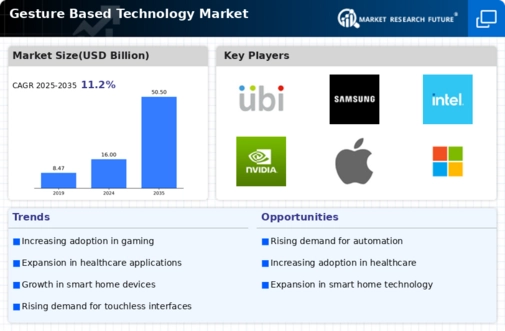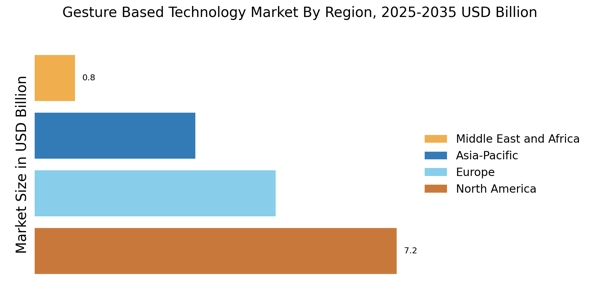Growth in Automotive Applications
The automotive sector is increasingly incorporating gesture-based technology, significantly impacting the Gesture Based Technology Market. With the rise of smart vehicles and advanced driver-assistance systems, gesture controls are being utilized for various functions, including infotainment and navigation. This trend is driven by consumer demand for enhanced convenience and safety features. Recent statistics suggest that the automotive gesture recognition market is expected to grow substantially, with projections indicating a potential market size of over 5 billion dollars by 2027. This growth is indicative of a broader trend towards integrating gesture-based interfaces in vehicles, enhancing the overall driving experience and promoting safer interactions.
Increased Investment in Smart Cities
The Gesture Based Technology Market is poised to benefit from the increasing investment in smart city initiatives. As urban areas evolve to incorporate advanced technologies, gesture-based solutions are being integrated into public infrastructure, enhancing interaction between citizens and city services. This trend is supported by government initiatives aimed at improving urban living through technology. Recent reports indicate that investments in smart city projects are expected to reach trillions of dollars over the next decade, creating a fertile ground for gesture-based applications. This integration not only improves accessibility but also promotes a more interactive urban environment, positioning gesture technology as a vital component of future city planning.
Rising Demand for Touchless Interfaces
The Gesture Based Technology Market is experiencing a notable surge in demand for touchless interfaces, particularly in environments where hygiene is paramount. This trend is driven by the increasing awareness of health and safety protocols, leading to a preference for non-contact solutions. Industries such as retail and hospitality are adopting gesture-based systems to enhance customer experiences while minimizing physical contact. According to recent data, the market for touchless technology is projected to grow at a compound annual growth rate of over 20% in the coming years. This growth reflects a broader shift towards automation and smart technologies, positioning gesture-based solutions as a key player in the evolving landscape of user interaction.
Integration with Augmented and Virtual Reality
The integration of gesture-based technology with augmented reality (AR) and virtual reality (VR) is transforming the Gesture Based Technology Market. This convergence allows for more immersive and interactive experiences, particularly in sectors such as gaming, education, and training. As AR and VR technologies continue to advance, the demand for intuitive gesture controls is expected to rise. Market analysis indicates that the AR and VR sectors are anticipated to reach a valuation of several billion dollars by the end of the decade, with gesture recognition playing a crucial role in user engagement. This synergy not only enhances user experience but also opens new avenues for application development, making gesture-based technology increasingly relevant.
Enhanced User Experience in Consumer Electronics
The Gesture Based Technology Market is witnessing a significant enhancement in user experience across consumer electronics. As manufacturers strive to differentiate their products, gesture recognition technology is being integrated into devices such as smart TVs, smartphones, and wearables. This integration allows users to interact with their devices in a more intuitive manner, fostering a seamless user experience. Market data suggests that the consumer electronics segment is projected to account for a substantial share of the gesture recognition market, with growth driven by innovations in user interface design. As consumers increasingly seek more engaging and user-friendly devices, the demand for gesture-based technology is likely to continue its upward trajectory.

















Leave a Comment